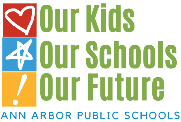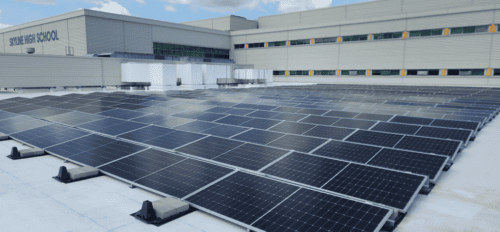AAPS upholds its promise to the Ann Arbor community by becoming the largest public-school owner/operator of solar power in the state of Michigan.

The voters of Ann Arbor and Ann Arbor Public Schools have charged the AAPS Capital Program team with the vision “to transform the student learning experience with the goal of providing for the health, safety, and well-being of all students in high quality, equitable, and environmentally sustainable schools.”
In December 2022, Ann Arbor Public Schools approved the Environmental Sustainability Framework, which recognizes that AAPS has been engaged in environmental sustainability efforts for decades. The current and looming climate crisis requires continued efforts to organize and institutionalize systemic changes, making this a critical time to renew, deepen, and align those efforts.
Creating resilient schools for climate change through sustainable and environmentally responsible infrastructure is consistent with the Framework and with one of four promises Ann Arbor Public Schools made to the citizens of Ann Arbor when the AAPS Capital Program Bond proposal passed. Kevin Stansbury, Design Program Manager at Gilbane, has been involved with the planning process from the earliest stages and he shared that “the toolboxes we’ve put together to make decisions on issues of environmental sustainability are not light work.”
AAPS staff and contractors are on the leading edge, nationally, for aligning environmentally sustainable buildings with best practices in teaching and learning. “It’s an amazing world,” Stansbury said. “One of the fun things, but also most challenging things, is that sometimes the sustainability and learning needs priorities are competing and there are complex tradeoffs to assess.” It takes a team of architects, designers, contractors, students, teachers, and administrators to create a plan that integrates these critical components of a 21st-century school district. “It’s such meaningful work,” Stansbury stated. “We’re doing it now and will do it until we’re done.”
Five Key Takeaways on Solar Energy and Environmental Sustainability
- AAPS is moving toward the goal of true carbon neutrality for the district, with policies that account for both embodied carbon and operating carbon emissions.
- The emphasis on rooftop solar panels maximizes clean, onsite renewable energy capture without detracting from nearby green spaces.
- The district currently operates twelve rooftop arrays yielding 2.1 megawatts of capacity, with the potential to save the district more than $6 million over the next twenty years.
- The AAPS Capital Program has plans in place to introduce even larger solar arrays in the future, bringing AAPS closer to 100% carbon neutrality and net zero operations.
1. Environmental Sustainability at Every Level
Sustainability is a district-wide promise to the community. AAPS is taking steps to actively reduce the carbon footprint of the district by using sustainable materials and creating net-zero (or fully carbon-neutral) buildings.
The district is charting a course for true carbon neutrality, including embodied carbon (the carbon within and expended creating the materials of existing structures) and operating carbon emissions (the amount of carbon emissions created from heating, cooling, and maintaining the buildings). Each building has been carefully assessed, using tools such as whole building life cycle assessments (WBLCA), to determine the level of environmental impact that would occur from keeping, retrofitting, or replacing the buildings. This holistic approach integrates sustainability efforts across multiple categories. “We have the ability and the responsibility to look under every rock,” Stansbury stated.
2. The District’s Unique Position for Effective Solar Installations
Jason Bing, Director of Capital Programs for Ann Arbor Public Schools, is excited to make the vision of the AAPS Capital Program a reality. “Working on healthy, high performance (or green) buildings for our students and staff is rewarding work. Our commitment to sustainability keeps me going to work every day.”
One of the very first steps in the pursuit of environmentally responsible buildings is using renewable energy sources for electricity. Instead of relying on utility companies to slowly shift the percentage of electricity sources to renewables, AAPS has taken steps to generate renewable energy on site, becoming a leader among public institutions across the state.
The district is using best practices across disciplines to decide the best location for solar array installation. AAPS has 36 buildings within the district, and many have flat roofs—or flat roofing sections—which can create an ideal place for installing solar panels. By utilizing roof arrays, the district protects greenspace and keeps land available for sports and recreation facilities. Rooftop solar panels also allow more greenery and trees to remain near the solar arrays without loss of generative capacity, allowing the district to maintain current trees and plant more trees for beauty, shade, carbon offset, and supporting local ecosystems.
3. Current Project Status
Another point of pride lies in the progress AAPS has made installing solar panels in the district. “As a public school district we are the largest owner/operator of solar energy in the state of Michigan,” said Bing. “We have 12 rooftop arrays, and 2.1 megawatts of capacity, and are fully operational with the two arrays installed this past summer. That is a significant number for any institution.”
To put that number in perspective, 2.1 megawatts is enough to charge the batteries of approximately 40 electric cars, or power over 1000 homes. This is a huge amount of electricity produced on site within the district, but it is still just the beginning.
In addition to generating electricity, the district is working to save electricity by using more efficient lighting and devices. In the 2022/2023 school year the district reduced electricity usage by an average of 25% by installing high efficiency LED lighting. That same year, the district saved approximately $180,000 in electricity costs from the energy generated from on-site solar panels. In the coming years, the savings will only increase, as more solar panels are added, and more efficient systems are installed. According to data estimated through the National Renewable Energy Laboratory and using the current cost of electricity, the savings to the district’s general fund are predicted to be more than $6 million over the next twenty years.
4. AAPS Leading the State in Solar Power
Ann Arbor Public Schools is the first public school system to commit resources to renewable energy generation at this scale in the state of Michigan. AAPS is leading the state—even ahead of many state colleges and universities—in implementing renewable energy generation at scale. “We’re making really exciting investments in our new buildings. We’re utilizing the Collaborative for High Performance Schools (US-CHPS) green guideline, such that every one of our buildings will be all-electric, net-zero-ready buildings and meet a verified leader status – the highest level of achievement through the program,” said Bing.
AAPS is also the first K-12 school district in the state to enroll in DTE Energy’s MIGreenPower program. Through MIGreenPower, DTE is investing in solar and wind power generation across the state of Michigan, reducing the total carbon emissions of the energy company, and offsetting more than 80% of the electricity used by Ann Arbor Public Schools. These are strategic steps moving the district ever closer to 100% renewable energy consumption.
5. Long-term Goals and Future Plans
Full carbon neutrality is the ultimate goal of Ann Arbor Public Schools. The first steps in achieving this goal are renewable energy, reduced operating emissions, and eliminating waste. The solar power arrays are an incredibly important part of this continued work.
In an interview with WEMU, Bing explained that growing the solar power capacity of AAPS is part of the district’s vision. “We will certainly be investing more, not only because they are sound investments that help us meet our overall carbon neutrality goals and save us money,” Bing shared, “but DTE and the MPSC have recently changed some of the regulatory restrictions, which, basically, remove a cap that had been limiting the scale of systems. So, we expect to actually be able to introduce larger rooftop arrays in the future. And that offers a lot of possibilities for the district.”
Other Sustainable Initiatives
Making the Ann Arbor Public Schools resilient for climate change is a multifaceted project. Using renewable energy sources is only the first step. At the same time, the district is also reducing carbon emissions by switching to geothermal heating and cooling systems (a process of using underground water pipes and compression) to replace fossil fuel-burning boilers and chemical-powered air conditioning units.
Cutting back on fossil fuels also means changing the fleet of buses AAPS uses to transport students to and from schools. Currently, the district has 4 electric buses and has applied for grant funding to add 10 more electric buses during the 2024/2025 school year. The electric buses are able to be charged at AAPS’s transportation hub and use clean energy sources.
As the district moves forward with the AAPS Capital Program bond and sinking fund initiatives, existing buildings will be renovated and new buildings will be constructed to the highest standards of environmental responsibility. “AAPS is investing in the future,” said Bing. “New, 21st-century buildings are going to draw people here, where there’s a serious commitment to environmental sustainability for our current and future students. We hope parents and community members get really excited about what this investment means.”

